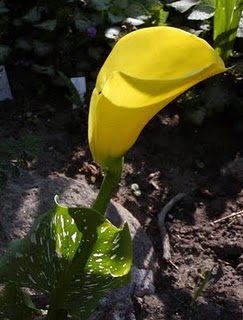
We have an underground stone root cellar. It’s one thing I love about old farmhouses. I love old farmsteads! They have such character and so many details that are left out of the newly built homes and barns.

Some cold cellars are built into a hillside, separate from the house, but that makes them difficult to access during the hard, cold, stormy winter when the doorway is buried under feet of snow.

Our cold cellar is in the basement, under the front porch to be exact. Our basement is unfinished and unheated throughout the winter and so is the cold cellar.

Cold cellars are also called “root cellars” but are not necessarily used just for roots. They can also be used to store jars of jams, pickles, etc, as well as tender and tropical bulbs and plants that need to stay above freezing in the winter. It can also be used as a spare fridge during cold weather. This is a box of eggs destined for the Salvation Army Soup Kitchen, being stored in our cold cellar.
The cold cellar needs to be below the frost line to keep the food from freezing, but unheated to keep it cold enough. It also needs to be a bit damp, as most underground cold cellars are.

So many vegetables that we grow in the north can be kept all winter in the right conditions. Unfortunately, it is sometimes difficult to provide just the right conditions for every vegetable. Each one can require something different. All you can do is provide what you can and check on them often, removing first the ones that look like they are not going to go the distance. This is where a canner or freezer comes in handy. After the first winter with a cold cellar and your vegetables, you will have a general idea of what you can keep in your cellar and what needs to be kept in a different environment.
Below is a list of a few of the most common vegetables that we have in this area and how to keep them in a cold cellar. Some of them do not require “cold” but can be hung and kept dry at room temperature. Very few vegetables will survive being kept damp at room temperature. We sometimes pack things like carrots in damp sand. We try not to use peat, since it is a quickly dwindling natural resource.

Important Note: Do not store apples (or anything else that produces ethylene gas) in the same room with other vegetables or fruits, It will cause them to ripen and sprout prematurely. Potatoes are especially susceptible. Yes, this means you cannot store your potatoes and apples in the same room, unfortunately–not if you expect the potatoes to keep very long.
- Carrots: Pack in damp sand. Keep damp and very cold, just above freezing.

- Onions and Garlic: Keep dry at room temperature. Separate them until the tops are completely dry then braid the tops and hang the braids in your kitchen for a country decoration or hang in netting to keep dry. You can also dry them and make your own onion/garlic powder. Commercial spices contain filler. Homemade is so much better!
- Most Hard Skinned Winter Squash: After curing at room temp, store in a cool but not too cold, dry area with good air circulation. No cold cellar needed for these. Shelves in a closet with openings in the door would be a good place, but not in the bathroom or kitchen where it will be too damp. Store acorn squash in a slightly cooler and moister environment without curing.
- Cabbage: Hang in a damp cold cellar, roots and all, or cut heads, remove loose outer leaves and spread one layer deep on shelves in a damp root cellar. Keep as damp and as close to freezing as possible.
- Rutabagas and Turnips: Cool (not too cold) and dry. Do not wash before storing. You can give rutabagas a quick, light dip in hot wax to seal them in order to keep them even longer, but they will keep for a few months in the right conditions without the wax.
- Potatoes: Keep just above freezing (40*F). If you wash them after digging, make sure they are dry before packing in boxes for storage.
- Beets: Cut the tops to 1″ and don’t cut the root tip off. Store very cold, just above freezing and very damp.
- Apples: Store very cold, just above freezing and very damp. Do not store with other vegetables.
I know it’s hard to find a separate place to keep apples just above freezing. Perhaps it is possible to close off a small corner with heavy, air tight plastic. I have considered doing this but have not tried it yet. I may do that this year, if we buy apples in bulk.


I also store my tender bulbs in the cold cellar. I grow cannas, calla lilies, dahlias, glads and elephant ears. I wrap them in newspaper and set them directly on the cold stone. It has worked well, so far!
Sheryl – Runningtrails blogs at Providence Acres Farm. Do you have a recipe post or kitchen-related story to share on the Farm Bell blog? See Farm Bell Blog Submissions for information and to submit a post.
Want to subscribe to the Farm Bell blog? Go here.




GrannyTrace says:
Wonderful information thanks for sharing Sharon. I did not know I could not store apples with other things in basement.
Have a great weekend
Granny Trace
http://www.grannytracescrapsandsquares.com
On May 29, 2011 at 7:40 am
GrannyTrace says:
ooops left off I love your stone root cellar!!
On May 29, 2011 at 7:41 am
brookdale says:
Great post! It reminds me of my grandparents’ cellar. I remember going down there in the wintertime to get a jar of something in the “canning room” and seeing all the vegs. The potatoes were spooky when the sprouts would start to come out! The apples were in barrels, in a separate “room”.
Winter squash were stored under the beds in the unused upstairs bedrooms, and onions were hung up there too.
Thanks for the memories!
On May 29, 2011 at 8:00 am
lisabetholson says:
Better information than most books give. Can you put your wine in there also or does it have to be dry and cold?
On May 29, 2011 at 9:34 am
Cathy Jones (catray44) says:
I love this post. We had a root seller in our old house. Sadly, I did not know how to use it. There is so much great information in your post, Sheryl, that I wish I had known back then. I have had good success over wintering Northern Spy,and a few other kinds of good keeping apples in my garage. I layer them with newspapers inside half bushel baskets and then covered them with an old sleeping bag. I only loose a handful by March.
On May 29, 2011 at 9:46 am
Sheryl - Runningtrails says:
Yes, I do keep my wine there too. It has to be kept cold, since it is organic. I haven’t had any mold problems yet, although I am considering sealing the corks with wax. It is probably not necessary, but for years of storage, might be a good idea.
I’m glad everyone likes the post! I love our cellar!
On May 29, 2011 at 10:54 am
Miss Judy says:
Very informative! My Grandmother kept her apples in a bushel basket in the bedroom that was unheated. She had a wood stove and if a door were closed or curtained off it was cold! My mother has a 58 year old Gibson refrige in her basement that keeps apples for ever! My son has a root cellar but the only thing they use it for is a tornado shelter!
On May 29, 2011 at 7:36 pm
indiaellerbee says:
I am looking for information on how to keep spring and summer vegetables, such as tomatoes and yellow and zucchini sqaush from my garden fresh longer than normal. Any suggestions appreciated. Thanks.
India
On May 7, 2012 at 9:32 pm
STH says:
Hi India,
Suzanne has a post here on freezing summer squash, so you might try that: http://chickensintheroad.com/cooking/saving-squash-and-zucchini/. I think that would be your best bet for summer squashes, which aren’t as hard as winter squash and don’t keep as well. Tomatoes can be cored and frozen whole, made into sauce and frozen, dehydrated, canned, etc., etc.; I would check the forum for more info on that as there are lots of experienced food preservers there.
On May 8, 2012 at 7:28 pm